Of Mother and Motherland

The New York Times best-selling author ALKA JOSHI talks about her journey from feeling embarrassed about her Indian heritage as a child to becoming its enthusiastic champion in her 50s, most notably through her wildly successful The Henna Artist and other novels.
(Photo credit for all photos of Alka Joshi: Garry Bailey)
The traveler has to knock
at every alien door to come to his own,
and one has to wander through all the outer worlds
to reach the innermost shrine at the end.
(From Journey Home by Rabindranath Tagore)
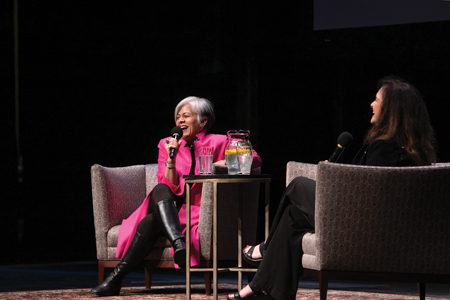 This epigraph from The Henna Artist, Alka Joshi’s widely popular debut novel from the Jaipur Trilogy, could well be Joshi talking about herself. After a lifelong career in advertising spinning stories for her clients, she has now come to penning stories of themes that are important to her—mother, home, homeland.
This epigraph from The Henna Artist, Alka Joshi’s widely popular debut novel from the Jaipur Trilogy, could well be Joshi talking about herself. After a lifelong career in advertising spinning stories for her clients, she has now come to penning stories of themes that are important to her—mother, home, homeland.
[Right] Thanks to her runaway success as a New York Times best-selling author, Alka Joshi is now a leading interpreter of Indian culture in the U.S.
“It wasn’t until my 50s, during my frequent visits to Jaipur with my mother, that I viewed India through my parents’ eyes and began to appreciate my birth country's rich and diverse history. Weaving that history in my narratives and having it resonate with millions of readers around the globe has been immensely rewarding,” says Joshi.
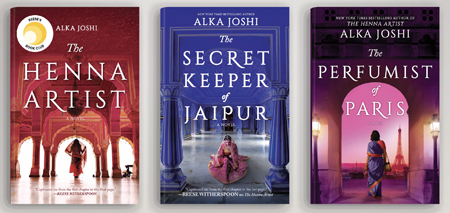
[Top] Joshi’s Jaipur Trilogy, besides providing beautiful glimpses of Indian culture and settings, celebrates themes of sisterhood, motherhood, and feminism—landing her in the enviable Forbes 50 over 50 list.
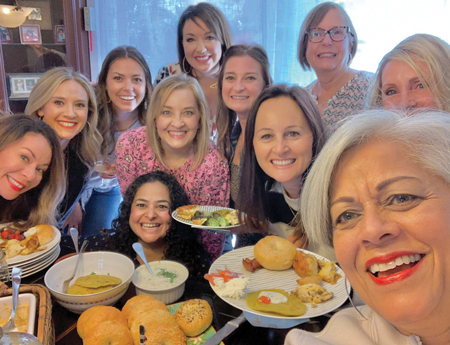 Despite its release during the pandemic, The Henna Artist, which traces the life of Lakshmi, a henna artist in a newly independent India, immediately became a New York Times Bestseller and a Reese Witherspoon Pick. It was quickly followed by The Secret Keepers of Jaipur and The Perfumist of Paris—together now known as the Jaipur Trilogy. Translated into 29 languages, another big moment for The Henna Artist came when Netflix acquired the rights for a screen adaptation in 2021. Last year, in 2023, Joshi was selected to the Forbes 50 over 50 list of empowered and powerful women.
Despite its release during the pandemic, The Henna Artist, which traces the life of Lakshmi, a henna artist in a newly independent India, immediately became a New York Times Bestseller and a Reese Witherspoon Pick. It was quickly followed by The Secret Keepers of Jaipur and The Perfumist of Paris—together now known as the Jaipur Trilogy. Translated into 29 languages, another big moment for The Henna Artist came when Netflix acquired the rights for a screen adaptation in 2021. Last year, in 2023, Joshi was selected to the Forbes 50 over 50 list of empowered and powerful women.
For our conversation, Joshi and I connect on Zoom. When she appears on my screen, she is in her signature look with a chunky bead necklace, thick-rimmed glasses, and red lipstick that contrasts with 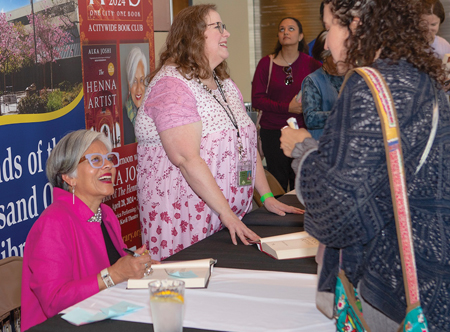 her thick mop of silver-grey hair. With her winning smile, it is easy to forget the celebrity author she is. And she makes it easier—throughout the time we talk, Joshi says “you and I” often, inviting me to connect with her. In that small virtual box, she has managed to create a space that feels real.
her thick mop of silver-grey hair. With her winning smile, it is easy to forget the celebrity author she is. And she makes it easier—throughout the time we talk, Joshi says “you and I” often, inviting me to connect with her. In that small virtual box, she has managed to create a space that feels real.
This conversation has been a long time coming. We had first connected during the pandemic—just after the launch of The Henna Artist. In the three years since, she has launched three books to wide acclaim, and I have spent that time nursing three beings in my family. “Why do you think these things happen in waves?” she asks as soon as we begin. She is referring to my family. Her question sets the tone for our conversation, and I lean in.
[Left 3 photos] Joshi is known for her uncanny ability to connect with her readers at book signings and book clubs.
In my world, the squirrels are hopping outside my 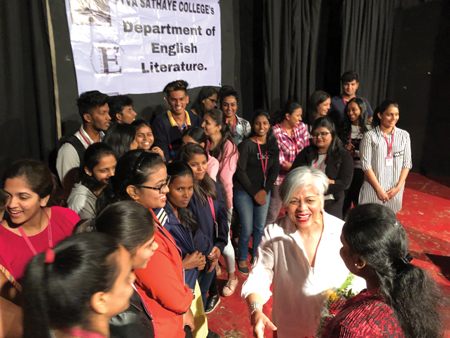 window. In hers, her husband has just called to remind her of something. Despite the many differences, which include those of location and time, it’s afternoon for both of us and I find it easy to talk to her about my family, about my dog-son who I had recently lost to sickness. She talks about hers. “My husband couldn't let him go,” she tells me. “I think it was the kindest thing we could have done,” she adds gently.
window. In hers, her husband has just called to remind her of something. Despite the many differences, which include those of location and time, it’s afternoon for both of us and I find it easy to talk to her about my family, about my dog-son who I had recently lost to sickness. She talks about hers. “My husband couldn't let him go,” she tells me. “I think it was the kindest thing we could have done,” she adds gently.
I am aware I am not the only one who has noticed Joshi’s uncanny ability to connect, having heard the same sentiment from readers who have interacted with her in their book clubs. While it is easy to see that she has fun interacting with her readers, it is also important to her for a more personal reason. “When I was younger, I often wrote to authors. And back then, you couldn't just do it on social media or send an email. You had to write to their publishers. So, I wrote to publishers about why that book really spoke to me. But I never once heard back. And it hurt me because I was pouring my heart out in these letters. So, when I became an author, I decided that if anybody wants to tell me something about my book or ask a question, I'm going to make myself available because it's important for them to be able to say what they need to.”
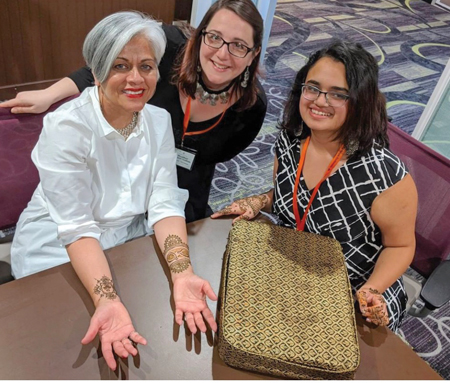 And now she listens patiently as I respond to her question about why things happen in waves. I talk about my belief in karmic theory and collective destinies, about the Indian beliefs that I carry with me. She can relate. “We lean on our cultural beliefs in times of need. In that sense, we carry our culture with us,” she says. It is a theme that is close to her heart.
And now she listens patiently as I respond to her question about why things happen in waves. I talk about my belief in karmic theory and collective destinies, about the Indian beliefs that I carry with me. She can relate. “We lean on our cultural beliefs in times of need. In that sense, we carry our culture with us,” she says. It is a theme that is close to her heart.
A nine-year-old comes to America
Discovering cultural moorings has been important for Joshi who arrived here as a child. “As an immigrant to the U.S. at the age of nine, I was confronted with a wholly negative Western perception of India. In the America of 1967, India was seen as dirty, ‘third-world,’ and mired in poverty. As a child who wanted to be accepted in American society, I embraced that misperception and eschewed my Indian heritage. I had a huge feeling of shame, embarrassment, and lack of pride in India. I didn't even want to tell people I was from India! I have these blue eyes—so people think I'm Italian, Brazilian, or Greek. And, at the time, I was like: whatever you want to think is fine as long as you don't think I'm Indian.”
A 50-year-old rediscovers her mother and her motherland
Joshi carried these feelings about India until her 50s when she took some trips to Jaipur with her mother. Not only did she rediscover her motherland on those trips but also her mother. “It wasn't until I started going back with my mother, Sudha Latika Joshi (nee Harit) to India that she told me, ‘You know, I love India. I never would have left. I never wanted to go to the United States.’ It shocked me that she felt that way because she'd never said anything like it when we were in America.”
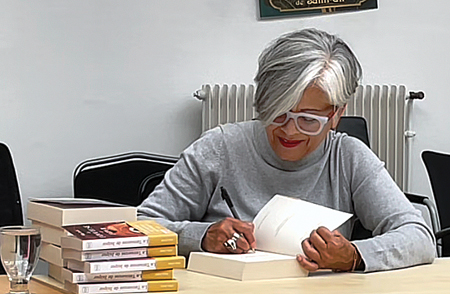 Inspired by these conversations, Joshi wished to give her mother the life she had wanted. And in fiction, Joshi found a way to do that—she has often talked about how Lakshmi, the main character in her books, is a reimagining of her mother’s life if she had had the agency to choose. “My mother answered my questions with honesty about her life, her girlhood dreams, her regrets, and her triumphs—all of which turned into heartfelt narratives,” says Joshi.
Inspired by these conversations, Joshi wished to give her mother the life she had wanted. And in fiction, Joshi found a way to do that—she has often talked about how Lakshmi, the main character in her books, is a reimagining of her mother’s life if she had had the agency to choose. “My mother answered my questions with honesty about her life, her girlhood dreams, her regrets, and her triumphs—all of which turned into heartfelt narratives,” says Joshi.
[Right] The recession of 2008 gave her an opportunity to pivot to writing– something her husband had long suggested she do.
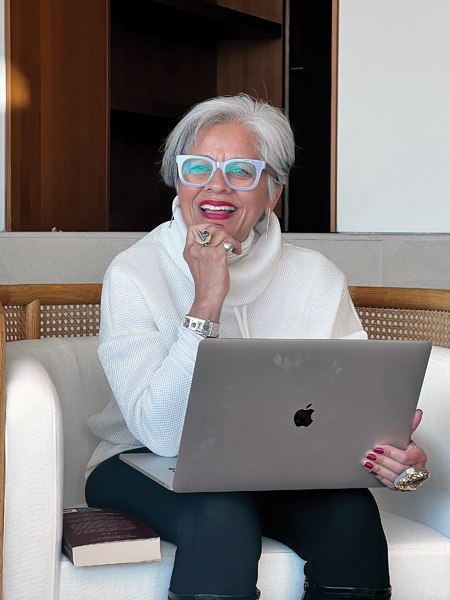 While Joshi’s mother may not have had the agency to choose her life, she made sure Joshi did. “My mother believed—more than I did—in my ability to excel in whatever I attempted. In school, when I brought my English essays home, or later when I showed her the ads I was creating for TV or print mediums, she claimed they were the best she’d ever seen—spoken like a mother who believed in her daughter. Even when I began writing fiction—much of it in Jaipur where we stayed in my brother’s condo—she encouraged me to keep going, to persist.”
While Joshi’s mother may not have had the agency to choose her life, she made sure Joshi did. “My mother believed—more than I did—in my ability to excel in whatever I attempted. In school, when I brought my English essays home, or later when I showed her the ads I was creating for TV or print mediums, she claimed they were the best she’d ever seen—spoken like a mother who believed in her daughter. Even when I began writing fiction—much of it in Jaipur where we stayed in my brother’s condo—she encouraged me to keep going, to persist.”
At this point I can't help asking: we can see the influence of her mother’s life but where is Joshi in her books? Seeing Joshi’s blue eyes in our video call reminds me that Lakshmi too has blue eyes. But more than just the eyes, every character in her books has some part of her, according to Joshi. “Lakshmi is very entrepreneurial. That's me. I'm always thinking: could I turn this into an opportunity? I also think that anytime there is a character who is feeling a little unsure of what their identity is: that's me. The insecurities that Lakshmi has about her life—whether she's doing the right thing, whether she's brought shame to her family—those are all feelings that I have had. And then just like Lakshmi had to let Malik go, it's been important for me to let go of certain people in my life in order to grow.”
There is also more of her in her forthcoming books. We have already established that we are both dog people, so her joy is palpable as she shares her plans for a book about dogs. “I have my little dachshunds, and so, I've been drawing these little dachshund stories over the years. I hope to go back and do more of those little books.” But before she does that, two of her other books are slated to come out.
A writer on the roll explores identity and celebrates Indian arts
One of them, Six Days in Bombay, is already available for pre-order. It is inspired by the life of Amrita Sher-Gil, the famous half Indian-half Hungarian painter. The choice of this subject comes naturally to Joshi who studied art history as an undergrad at Stanford University. “I've always wanted to write a story around Amrita Sher-Gil. In 2019, I went to see her paintings at the National Gallery of Modern Art in New Delhi. They are huge and one can actually imagine what her artistic vision was.
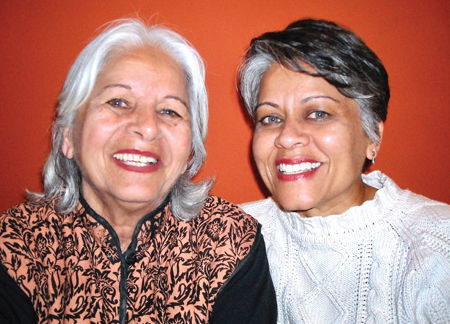 In Six Days in Bombay, just like Sher-Gil, the main character, Mira, is a painter. She is also flamboyant, sexually-fluid, and confident. Also like Sher-Gil, she dies at a very young age. Before her death, she meets the half Indian-half British night nurse at the hospital. “Mira and the nurse bond over the fact that they are both half-caste. The nurse loses her job when Mira dies at the hospital, and she spends the rest of the novel following in the painter's footsteps all over Europe. But what the nurse is really chasing is identity and she will have a reckoning around that by the end of the novel.”
In Six Days in Bombay, just like Sher-Gil, the main character, Mira, is a painter. She is also flamboyant, sexually-fluid, and confident. Also like Sher-Gil, she dies at a very young age. Before her death, she meets the half Indian-half British night nurse at the hospital. “Mira and the nurse bond over the fact that they are both half-caste. The nurse loses her job when Mira dies at the hospital, and she spends the rest of the novel following in the painter's footsteps all over Europe. But what the nurse is really chasing is identity and she will have a reckoning around that by the end of the novel.”
[Left] With her mother, Sudha Latika Joshi– the inspiration behind Lakshmi, the strong female lead in The Henna Artist.
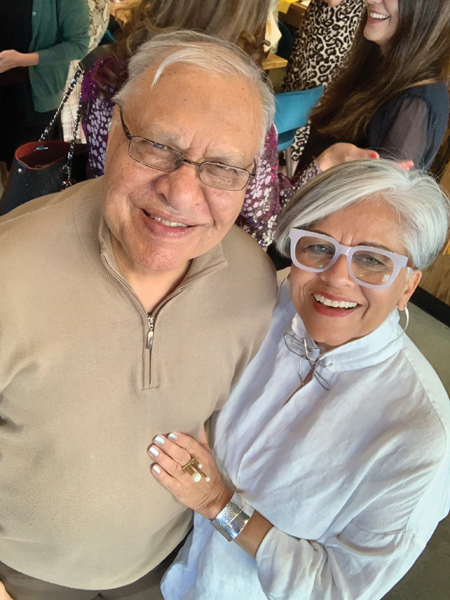 In writing this story about identity, Joshi is also exploring something that has often come up in her own life: where does our sense of self lie when we have dual identities? “Which part of that identity is the strongest and which is the one I lean on in hard times? These are the kind of questions that I wanted my characters to explore in the story.”
In writing this story about identity, Joshi is also exploring something that has often come up in her own life: where does our sense of self lie when we have dual identities? “Which part of that identity is the strongest and which is the one I lean on in hard times? These are the kind of questions that I wanted my characters to explore in the story.”
[Right] With her father, Ramesh C. Joshi, who she credits for her knowledge of Indian history and details of pre- and post-independence India.
Following closely after Six Days in Bombay is Joshi’s book about kathak dancers. “That’s my fifth book which I'm currently writing—about a young girl who, in 1920s, was not allowed to study kathak because it was considered the domain of courtesans. And kathak being a storytelling dance, I'm telling the story of a girl who wants to tell a story through the medium of dance. I am loving this process of discovering this amazing art form. One of the things I’ve found is that kathak is a precursor to ballet. People think of ballet as an elegant art form from the West, but the stances, the story- telling, the facial expressions, the hand gestures, and the chakkars are very similar to the ancient dance we know in the East as kathak.”
Bonds of sisterhood and women empowerment
This story of an aspiring kathak dancer is not far away from the world of women and their aspirations that Joshi has explored in her first book, The Henna Artist. Feisty women fighting against abuse and braving opposition for economic and societal independence, for autonomy over their bodies. What draws Joshi to these themes? “I don't have domestic violence in my family, but I know women who have. So, I definitely wanted to touch on that. But I didn't want Lakshmi to be a victim. I wanted her to say: what can I do with my life now? I also wanted to touch upon all the other things that people think we should shy away from—like contraception, abortion, women wanting something for themselves other than marriage and children.”
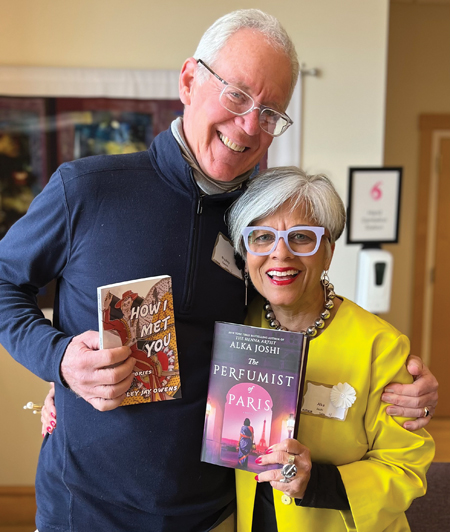 An interesting aspect of Joshi’s writing has been an exploration of sisterhood: a bond of understanding between women, of similar lived experiences. A friend holding a friend, a sister standing up for her sister, a mother-in-law supporting her daughter-in-law as she flees from her son’s abuse. “When I was in India and watched these soap operas on television, the mother-in-law in those soaps made life awful for the daughter-in-law. And I thought that I didn't want to perpetuate that stereotype. So, I created a mother-in-law for Lakshmi who is a very kind and empathetic woman.” Interestingly, Joshi also explores the humanity of Lakshmi’s abusive husband who becomes a healer later in the book.
An interesting aspect of Joshi’s writing has been an exploration of sisterhood: a bond of understanding between women, of similar lived experiences. A friend holding a friend, a sister standing up for her sister, a mother-in-law supporting her daughter-in-law as she flees from her son’s abuse. “When I was in India and watched these soap operas on television, the mother-in-law in those soaps made life awful for the daughter-in-law. And I thought that I didn't want to perpetuate that stereotype. So, I created a mother-in-law for Lakshmi who is a very kind and empathetic woman.” Interestingly, Joshi also explores the humanity of Lakshmi’s abusive husband who becomes a healer later in the book.
[Left] With husband Bradley Jay Owens—a writer himself—who encouraged Joshi to become a fiction writer.
As lines between imagination and reality intersect in Joshi’s books, a question that comes up is: to what end? What does Joshi think about her responsibility as an author? “Because I am writing about very serious things, if I can put the cloak of fiction around them, people can digest it, hear it, feel it. And my job is done! I write historical fiction to give voice to women who have been forgotten, women who were never recognized for all the good things they did to make our lives better. How selflessly they helped their husbands, their children, and other people in their lives succeed. But they never got the credit. That’s why I focus on women—imagine how much more they could contribute to our world if they were given the agency they deserve, the agency that is their right.”
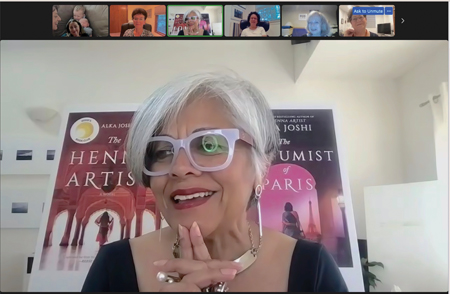 Joshi understands this firsthand as she witnessed how her mother was able to influence her father’s views on how Joshi’s life should look. “My father was—and is—a progressive thinker. He wanted all three of us, my brothers and me, to get an Ivy League education and explore opportunities around the world as he did. He was always my champion—proud and supportive of the choices I made, but he envisioned marriage and children for my future after college. My mother convinced him otherwise—to let me design my own life. He heard her and followed suit. As a newly-minted engineer in 1955, my father, Ramesh C. Joshi, helped build Rajasthan’s infrastructure. The history and colorful details of pre- and post-independence India, the India he lived through, that he’s shared with me, have added an authenticity to my stories I would have been hard-pressed to find otherwise.”
Joshi understands this firsthand as she witnessed how her mother was able to influence her father’s views on how Joshi’s life should look. “My father was—and is—a progressive thinker. He wanted all three of us, my brothers and me, to get an Ivy League education and explore opportunities around the world as he did. He was always my champion—proud and supportive of the choices I made, but he envisioned marriage and children for my future after college. My mother convinced him otherwise—to let me design my own life. He heard her and followed suit. As a newly-minted engineer in 1955, my father, Ramesh C. Joshi, helped build Rajasthan’s infrastructure. The history and colorful details of pre- and post-independence India, the India he lived through, that he’s shared with me, have added an authenticity to my stories I would have been hard-pressed to find otherwise.”
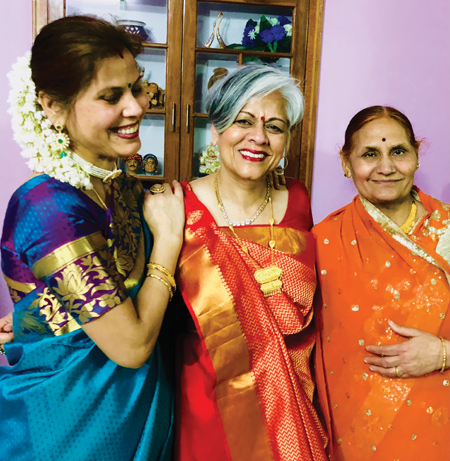 Joshi has often fondly talked of her husband, the original writer in the family, who became her other champion. “My husband kept telling me that I should study fiction writing. He thought I was a good storyteller, and that I could be a really good fiction writer. So, when the recession hit the market in 2008, I decided to use my time to study fiction writing. And then it just kind of evolved into what I do now.”
Joshi has often fondly talked of her husband, the original writer in the family, who became her other champion. “My husband kept telling me that I should study fiction writing. He thought I was a good storyteller, and that I could be a really good fiction writer. So, when the recession hit the market in 2008, I decided to use my time to study fiction writing. And then it just kind of evolved into what I do now.”
[Right] With family in Jaipur—the city that started the journey of rediscovery for Joshi.
Besides her runaway success in writing, Joshi is also looking forward to the proposed screen adaptation of The Henna Artist by Netflix. “It’s exciting to know that the strength of Indian women and the richness of my birth culture will reach many more millions with this streaming series. And to think that actress Freida Pinto is set to star as Lakshmi is beyond amazing!” As the original author and the executive producer, she is at hand for reviewing the script. “Because I'm the one who knows the story the best, I can let them know if a character wouldn't say a certain dialogue that way, if a particular character is coming on a bit strong, or if anything isn't in line with what I wrote. And though I give them my notes, they don't have to use them. I also understand that a screen adaptation is different from writing a book.”
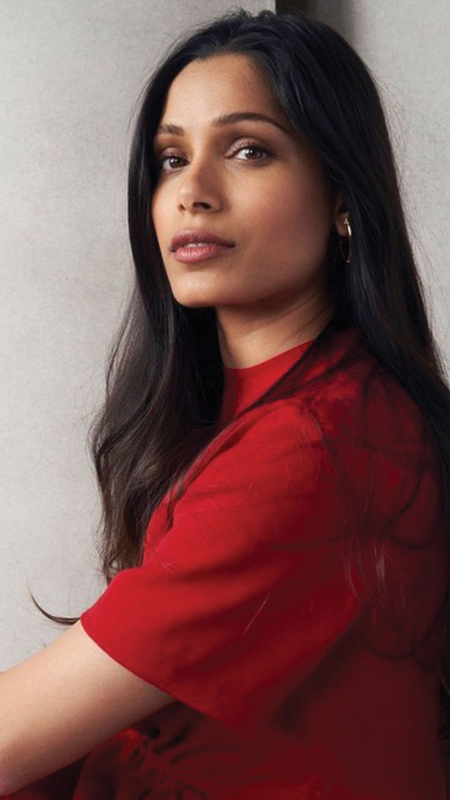
While the process may be different, Joshi is popular among readers for evoking the a similar sensorial experience of an audio-visual medium through her writing. “I'm a very visual learner; and because of my art background, I can visualize anything. I see it in full color.” And it’s more than just visual, says Joshi. “If I am writing about a train in India, I can smell the train. I can smell the coal, the smoke from that train, the subji the person in the train compartment is eating.”
When I ask her if she would consider writing for screen, “Never say never!” smiles Joshi for whom life has been full of surprises since her first book hit the market. The latest in that series of surprises has been her inclusion in Forbes 50 Over 50 women empowering other women. “When I learned that 10,000 women had been vetted for this list, I was flabbergasted to have been selected as one of fifty female CEOs, venture capitalists, innovators, inventors, and artists—proving that age is no barrier to creation.”
As Joshi talks about her experiences, it is easy to see that women's empowerment and sisterhood are not abstract for her. “Talking with you was like talking with a sister,” she says as we wrap up. With her empathy, her unassuming presence, and her ability to make one seen and heard, it is easy to believe that.
[Left] "When I read The Henna Artist, I felt a deep connection to the character of Lakshmi and knew I wanted to bring her to life. As both a woman and an actor, championing the agency of women is incredibly important to me, and this series will be a powerful step forward in that direction." says Frieda Pinto
Pooja Garg is the Deputy Editor for Khabar magazine. An award-winning journalist and USC Annenberg Fellow for Writing and Community Storytelling, Pooja has worked as Special Correspondent with India Today and as Delhi Bureau Chief for CIO magazine. Founder of the South Asian Collective and The Woman Inc, she is the author of Everyday and Some Other Days. She can be reached at pooja@khabar.com.
Elevenses with Alka Joshi
Which of your achievements are you most proud of?
My novels—because they are my most significant contribution to the understanding and appreciation of India and because they allow me to honor my parents.
What is your writing routine?
It varies. Sometimes, I write several hours a day. Other days, I think about my scenes or how to develop my characters, or I research about a specific item I’m including in the story, like erotic Victorian pocket watches or the best way to cook a puri. 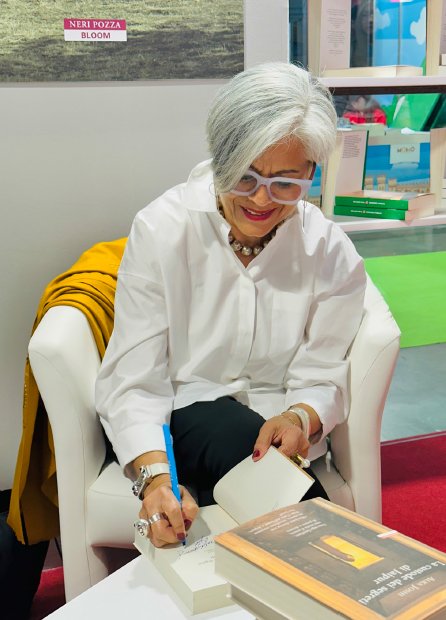
What is the best writing advice you have received?
Writing is rewriting; you must get used to having your work scrutinized by yourself and others and know that revising it will make it better, stronger.
Which is your favorite book?
There are too many to pick a favorite. I love Jane Eyre, The Inheritance of Loss, The Householder, The Color Purple, Malgudi Days, Nectar in a Sieve, The Blood of Flowers, and How I Met You to name a few. That last is a collection of stories by my talented writer-husband Bradley Jay Owens.
What is the one lesson from your advertising career that you apply in your writing life?
Meet your deadlines.
Do you have a favorite place to write?
My bed. And I like to write in my pajamas. I buy new pairs every year as my writing outfit :-)
Which is your favorite place to relax/holiday?
My town, which is by the seaside, quiet, and filled with friends who also love to walk, read, and create.
Which is your comfort food?
Cardamom ice cream (which my husband and I make at home).
With your background in art history which is your favorite painting?
I love including art history in my writing. To me, the examination of the visual is a natural story partner. While I do admire Manet’s Olympia, which features heavily in my third novel, The Perfumist of Paris, as well as Amrita Sher-Gil’s Young Girls, which features heavily in my upcoming novel, Six Days in Bombay, I also love Rajasthani miniature paintings and the works of Johannes Vermeer, Berthe Morisot, Maira Kalman, Edward Hopper, and Andy Warhol.
What is the one thing that you would like to share with your readers?
I hope that you take away from my novels the absolute right of women to determine their own futures without interference, and also the richness, wisdom, and strength of the Indian culture which survived a 200-year British rule and contributes so positively to the world today.
One more thing...
No one creates in a vacuum. I could never have written my novels without the gentle guidance of my husband, parents, brothers, teachers, editors, and my agent. It takes a village to write a good book.
Enjoyed reading Khabar magazine? Subscribe to Khabar and get a full digital copy of this Indian-American community magazine.
blog comments powered by Disqus










